历史
Main article: History of the University of Missouri
Establishment and pre-fire
In 1839, the Missouri legislature passed the Geyer Act to establish funds for a state university for the state's many aspiring students. It would be the first public university west of the Mississippi River. To secure the university, the citizens of Columbia and Boone County pledged $117,921 in cash and land to beat out five other central Missouri counties for the location of the state university. The land on which the University was eventually constructed was just south of Columbia's downtown and owned by James S. Rollins, who became known as the "Father of the University." As the first public University in Louisiana Purchase, the school was shaped by Thomas Jefferson's ideas about public education.
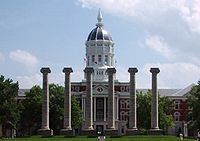
Francis Quadrangle, featuring the Columns and Jesse Hall
In 1862 the American Civil War forced the university to close for much of the year. It was during this time that the residents of Columbia formed a "home guard" militia unit that became notoriously known as the "Fighting Tigers of Columbia". This name was given because of the group's steadfast readiness to fight against any form of invading force that was hoping to plunder the city and university. Later, in 1890, the name suggested the University's newly-formed football team be called the "Tigers" for those who fought to defend Columbia. In 1870 the institution was granted land-grant status under the Morrill Act of 1862. The act also led to the establishment of the Missouri School of Mines and Metallurgy as an off shoot of the main campus in Columbia; This institution became the present-day Missouri University of Science & Technology. In 1888 the Missouri Agricultural Experiment Station opened. This grew to encompass ten centers and research farms around central Missouri. By 1890 the university encompassed a normal college (education), engineering college, art's and science college, school of agriculture and mechanical arts. school of medicine, and school of law. On January 9, 1892, Academic Hall, the institution's main building, fell victim to a disastrous fire. The fire completely gutted the building, leaving little more than six stone Ionic columns standing. The university's rebuilding, under the tenure of Missouri Governor David R. Francis laid the foundations for the modern university.
After the fire
After the fire, there was a campaign to move the University to Sedalia; however, Columbia was able to rally against the move. The columns, which still stand today, became a symbol of the campus and form the center of Francis Quadrangle, the oldest part of campus. At the southern end of the quad is Academic Hall's replacement, Jesse Hall, named for Richard Jesse (the president of the university at the time of the fire). Built in 1895, Jesse Hall is home to many administrative offices of the University and to Jesse Auditorium. The area of campus around the quadrangle, where the buildings are built of red brick, is known as "red campus."
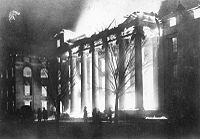
Fire at Academic Hall, 1892
East of the quadrangle, many buildings were built in 1913 and 1914 of white limestone. This section is known as "white campus." In 1908 the world's first journalism school was opened at MU. It became famous worldwide for its "Missouri Method" of hands-on, experience-based teaching. In 1910 George Kessler implemented a City Beautiful design of the grounds. In 1911, MU held the first homecoming when Athletic Director, Chester Brewer (another alumnus of Acacia Fraternity), invited alumni to "come home" for a spirit rally, a parade, and the football game between MU and the University of Kansas. After World War II, universities around the country grew at an extraordinary pace, and MU was no exception. This was due in part to the G.I. Bill, which allowed veterans to attend college with the assistance of the federal government.
Events at the University were instrumental in the desegregation of universities and schools nationwide. In the winter of 1935, four graduates of Lincoln University—a traditionally black school about 30 miles (50 km) away in Jefferson City—were denied admission to MU's graduate school. One of the students, Lloyd L. Gaines, brought his case to the United States Supreme Court. On December 12, 1938, in a landmark 6–2 decision, the court ordered the State of Missouri to admit Gaines to MU's law school or provide a facility of equal stature. Gaines disappeared in Chicago on March 19, 1939, under suspicious circumstances. The University granted Gaines a posthumous honorary law degree in May 2006. Undergraduate divisions were integrated by court order in 1950, when the University was compelled to admit African Americans to courses that were not offered at Lincoln University.
Flagship campus
The University of Missouri became a four campus system in 1963.
校园
MU is located in Columbia, Missouri just south of downtown. The campus is designated a botanical garden by the state of Missouri. The academic portion of campus is split into two main groups known as Red Campus and White Campus. Red Campus is the historical core of academic buildings situated around the landmark columns of the David R. Francis Quadrangle. Red Campus also includes buildings such as Jesse Hall and Switzler Hall. In the early 1900s, the College of Agriculture began a period of rapid expansion in which several buildings were constructed to accommodate the growing program and student body. The new buildings, located to the east of Red Campus, were built in neo-gothic style from native Missouri limestone. The most notable feature of White Campus is Memorial Union.
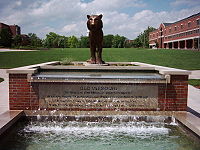
A fountain and statue make up Tiger Plaza, located on the southern edge of the Carnahan Quadrangle
During the 1990s, Red Campus was extended to the south side of Jesse Hall with the creation of the Carnahan Quadrangle. Hulston Hall of the University of Missouri School of Law had already been completed in 1988 and formed a natural eastern border for the future quad. The Reynolds Alumni Center was completed in 1992 on the west side of the new quad. The new quad was finished with completion of Cornell Hall of the Trulaske College of Business and Tiger Plaza in 2002.
While the original MU intercollegiate athletic facilities, such as Rollins Field and Rothwell Gymnasium, were located just to the south of the academic buildings, the venues began to move further south across Stadium Boulevard upon the completion of Memorial Stadium in 1926. The Hearnes Center was completed just to the east of the stadium in 1972. In 1994, the university developed the first draft of a master facilities plan for the campus that would tie together all of Tiger athletic facilities to the south of Stadium Boulevard into an attractive setting. Today, the MU Sports Park now also includes the Mizzou Arena, Taylor Stadium, Walton Stadium, Mizzou Athletics Training Complex, University Field and Devine Pavillion. Student athletic facilities remain in the core area of campus where the original intercollegiate facilities were once located. Rothwell Gymnasium and Brewer Fieldhouse are now part of the 283,579-square-foot (26,345.4 m) Student Recreation Center that was ranked number one in the nation by Sports Illustrated in the September 2005 issue.
Between the student recreation facilities and the intercollegiate athletic facilities lies the main campus of the University of Missouri Hospitals and Clinics. The complex includes the University of Missouri Hospital and Truman Memorial Veterans Hospital. Two of the hospitals, Columbia Regional Hospital and Ellis Fischel Cancer Center are located northeast of the main campus, near I-70.
Located south of the MU Sports Park along Providence Road is the MU Research Park. The research park includes the University of Missouri Research Reactor Center, International Institute for Nano and Molecular Medicine, MU Life Science Business Incubator at Monsanto Place, and Dalton Cardiovascular Research Center. In October 2005, the University of Missouri Board of Curators also approved legislation to designate the South Farm of the College of Agriculture, Food and Natural Resources (CAFNR) as a research park. The 114-acre (0.46 km) park, located three miles (5 km) southeast of the main campus on US63, is now known as Discovery Ridge Research Park. Tenants at Discovery Ridge include ABC Laboratories and the MU Research Animal Diagnostic Laboratory.
The main campus is flanked to the east and west by Greek Life housing. As one of the nation's largest Greek life systems, the University of Missouri includes nearly 50 national social fraternities and sororities, many of which make their homes in multi-million dollar historical residences. Beta Sigma Psi, Kappa Alpha Order, Sigma Chi, Beta Theta Pi, Alpha Gamma Rho, and Sigma Nu form a Greek Row (also called Frat Row) along College Avenue in the East Campus area. Most of the Greek letter organizations are arranged in a Greek Town, consisting of approximately 30 Greek residences, to the north of Memorial Stadium. Fraternities in "Greek town" consist of Delta Upsilon, FarmHouse, Phi Kappa Theta, Delta Sigma Phi, Delta Tau Delta, Alpha Kappa Lambda, Alpha Epsilon Pi, Pi Kappa Phi, Sigma Pi, Alpha Gamma Sigma, and Sigma Phi Epsilon. The sororities that neighbor these fraternities include Alpha Delta Pi, Kappa Delta, Kappa Kappa Gamma, Pi Beta Phi, Gamma Phi Beta, Delta Gamma, Delta Delta Delta, Chi Omega, Alpha Phi, Alpha Chi Omega, Zeta Tau Alpha, Kappa Alpha Theta, Sigma Sigma Sigma, and Phi Mu. Tau Kappa Epsilon, Kappa Sigma, and Lambda Chi Alpha reside in houses west of the MU Power Plant on Stewart Road.
学术
MU is one of only six public universities that houses a law school, medical school, and a veterinary medicine school all on the same campus. In Missouri, MU is the designated land-grant university (along with Lincoln University), the largest public research institution, and the only university that is both a member of the Association of American Universities and designated as a "Doctoral/Research Extensive" university by the Carnegie Foundation for the Advancement of Teaching. Only 34 universities in the nation have both such designations. The University of Missouri Research Reactor Center is located in the MU Research Park and is the largest university research reactor in the U.S.
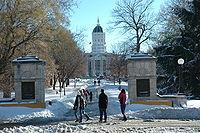
View of the Columns and Jesse Hall down the Avenue of the Columns
In 1908, the Missouri School of Journalism (known colloquially as the "J-school"), the world's first school of journalism, was founded in Columbia. The University of Missouri System also owns and operates KOMU-TV, the NBC/CW affiliate for Columbia and nearby Jefferson City. It is a full-fledged commercial station, but is also a working lab for journalism students. The MU School of Journalism also operates the Columbia Missourian which trains students in reporting, editing and design in a real newsroom managed by professional editors, local National Public Radio Station [KBIA]http://www.kbia.org/ and Radio Adelante, a Spanish-language radio program.
Founded in 1978 after 23 years as a unit of the School of Medicine, the School of Health Professions became an autonomous division by action of the University of Missouri Board of Curators on Dec. 14, 2000. The school's five departments and eight accredited academic programs have a long and distinguished history, some dating back to the early 1900s, and have produced many well respected and nationally recognized professionals. As Missouri's only state supported school of health professions on a campus with an academic health center, and the only allied health school in the University of Missouri system, the school is uniquely positioned to educate highly qualified health care professionals, who, in addition to becoming skilled practitioners, will assume leadership responsibilities as faculty, researchers, and administrators in their respective disciplines.
The university maintains the second largest library collection in the State of Missouri. As of the 2006-2007 academic year, the collection was home to nearly 3.1 million volumes, 8.1 million microforms, 1.7 million government documents, more than 272,000 print maps, and more than 49,000 journal subscriptions. The collection is housed in Ellis Library, the University Archives, and seven specialized academic libraries across campus. The collection was originally house in Academic Hall, and most of it was lost when the building burned in 1892. The only materials that survived were those that were checked out at the time. During the American Civil War, Union troops used the Library as a guard room. The Union troops caused significant damage, including taking 467 library volumes to construct fires. The Board of Curators later sued the Army for the destruction they caused to the library and other parts of campus. The suit was eventually settled in 1915 and the award was used to build the Memorial Gateway on the northern edge of Red Campus. In 1913, construction began on a new main library for the campus, and in 1915 it was completed and the collection was moved from Jesse Hall to the newly constructed library. The main library was expanded in 1935, 1958, and 1985. It was dedicated as Elmer Ellis Library on October 10, 1972, in honor of the thirteenth president of the University of Missouri. Today, the MU libraries are home to the 47th largest research collection in North America.
Organization and administration
| College/school founding |
| College/school |
Year founded |
|
| College of Arts and Science |
1841 |
| College of Education |
1868 |
| College of Agriculture, Food and Natural Resources |
1870 |
| School of Law |
1872 |
| School of Medicine |
1872 |
| College of Engineering |
1877 |
| Graduate School |
1896 |
| School of Journalism |
1908 |
| Trulaske College of Business |
1914 |
| Sinclair School of Nursing |
1920 |
| College of Veterinary Medicine |
1946 |
| School of Social Work |
1948 |
| School of Music |
???? |
| School of Health Professions |
???? |
| School of Accountancy |
1975 |
| School of Natural Resources |
1989 |
| College of Human Environmental Sciences |
1960 |
| School of Information Science & Learning Technologies |
1997 |
| Harry S. Truman School of Public Affairs |
2001 |
Presidents and chancellors
Each campus of the University of Missouri System is led by a chancellor, who reports to the president of the UM System. Prior to the formation of the system in 1963, the Columbia campus and its offshoot in Rolla were led directly by the president and the position of chancellor did not exist. See University of Missouri System#Presidents for a list of presidents from 1963–present. This list does not include interim presidents or chancellors. John Lathrop is the only president or chancellor to have served separate terms.
Presidents, 1841–1963 and Chancellors, 1963–present
- John Hiram Lathrop (1841–1849)
- James Shannon (1850–1856)
- William Wilson Hudson (1856–1859)
- Benjamin Blake Minor (1860–1862)
- John Hiram Lathrop (1865–1866)
- Daniel Read (1866–1876)
- Samuel Spahr Laws (1876–1889)
- Richard Henry Jesse (1891–1908)
- Albert Ross Hill (1908–1921)
- John Carleton Jones (1922–1923)
- Stratton Brooks (1923–1930)
- Walter Williams (1931–1935)
- Frederick Middlebush (1935–1954)
- Elmer Ellis† (1955–1963)
- John W. Schwada (1964–1970)
- Herbert W. Schooling (1971–1978)
- Barbara Uehling (1978–1987)
- Haskell Monroe (1987–1993)
- Charles Kiesler (1993–1996)
- Richard L. Wallace (1997–2004)
- Brady J. Deaton (2004–present)
† Elmer Ellis became president of the University of Missouri System upon its creation, serving until 1966.
From its inception in 1839 until the creation of the University of Missouri System in 1963, the university in Columbia was known simply as the University of Missouri. Upon creation of the system, each university was renamed with its host city; thus, the university in Columbia became the University of Missouri–Columbia. In the proceeding decades, colloquial and verbal usage of the generic name in reference to MU continued. There were various attempts to drop Columbia from its name by students, faculty, alumni, and administrators who felt it might cause the university to be perceived as a regional institution. This change was long resisted by the UM System and the other universities on the basis of uniformity and fairness. However, after a renewed effort for "name restoration", the Board of Curators voted unanimously on 29 November 2007 to allow MU to drop Columbia from its name for effectively all public purposes. Continued use of the name University of Missouri–Columbia is not incorrect but is being phased out by MU, except as required on official internal documents within the UM System. Its use also continues to be advocated by some faculty, administration, and alumni of UMKC, UMSL, and Missouri S&T.
Student life
Residential Life
|
Dobbs Area
Residence Halls:
- Jones Hall (1957)
- Lathrop Hall (1957)
- Laws Hall (1957)
- North Hall (2006)
- Center Hall (2006)
- South Hall (2006)
Dining Halls:
Convenience Store:
|
|
Pershing/Mid-Campus Area
Residence Halls:
- Cramer Hall (1947)
- Defoe-Graham Hall (1939/47 & 2009)
- Stafford Hall (1947)
- Galena Hall (2009)
- Dogwood Hall (2009)
- Hawthorn Hall (2009)
Dining Hall:
Convenience Store:
- Mizzou Market: Hitt Street
|
|
College Avenue Area
Residence Halls:
- Discovery Hall (2004)
- Excellence Hall (2004)
- Responsibility Hall (2004)
- Respect Hall (2004)
- Hatch Hall (1962)
- Schurz Hall (1962)
- College Avenue Hall (2006)
Dining Halls:
- Plaza 900 (2004)
- Baja Grill
|
|
Rollins Area
- Gillett Hall (1965)
- Hudson Hall* (1965)
- Johnston Hall (1947)
- Wolpers Hall (1963)
Dining Halls:
- Rollins
- Eva J's
- Plaza 900
|
|
Mark Twain Area
Residence Halls:
- Mark Twain Hall (1965)
- McDavid Hall (1956)
Dining Halls:
|
- * Indicates currently being constructed or closed for renovation
Groups and activities
Tap Day is an annual spring ceremony in which the identities of the members of the six secret honor societies are revealed. The participating societies are QEBH, Mystical Seven, LSV, Omicron Delta Kappa, Mortar Board, and the Rollins Society. The ceremony, first held in 1927, takes place at the base of the Columns on Francis Quadrangle.
The University of Missouri is also home to The Associated Students of the University of Missouri. ASUM is a student run lobbying organization that represents the students interests in Jefferson City and Washington, D.C. ASUM's platform has included issues such as equalizing the Access Missouri grant, expanding Bright Flight funding, and giving students a vote on the Board of Curators.
Greek Life
Main article: MU Greek Life
MU is home to one of the oldest and largest Greek systems in the nation. The University is home to the first chapter of an existing national fraternity founded at a public institution west of the Mississippi. Currently, more than 70 Greek-letter organizations remain active at MU.
体育运动
Main article: Missouri Tigers
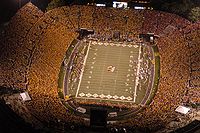
Faurot Field during a football game
The Missouri Tigers are members of the Big 12 Conference. Mizzou is the only school in the state with all of its sports in the NCAA Division I, the nation's highest level of college sports. Their colors are black and gold. Athletic sports include men's and women's basketball, baseball, cross country, football, golf, gymnastics, lacrosse, swimming & diving, softball, track, tennis, volleyball, women's soccer, and wrestling. Former football coach Dan Devine holds the record for most wins on the gridiron. Additionally, former basketball coach and alum Norm Stewart maintains the record for most wins on the hardcourt. The current head coach of the men's basketball team is Mike Anderson. Gary Pinkel is the current head football coach. Coaches of other sports include women's basketball coach Cindy Stein, women's golf coach Stephanie Priesmeyer, men's golf coach Mark Leroux, baseball coach Tim Jamieson, softball coach Ehren Earleywine, cross country coach Jared Wilmes, men's swimming and diving coach Brian Hoffer, track and field coach Rick McGuire, wrestling coach Brian Smith, gymnastics coach Rob Drass, soccer coach Bryan Blitz, tennis coach Blake Starkey, and volleyball coach Wayne Kreklow.
MU football games are played on Faurot Field at Memorial Stadium, in addition to recent games played at Arrowhead Stadium in Kansas City, Missouri (versus the University of Kansas) and at the Edward Jones Dome in Saint Louis, Missouri (versus the University of Illinois). Built in 1926, the stadium has an official capacity of 71,004, and features a nearly 100 ft (30 m). wide "M" behind the north end zone. Men's and women's basketball games are played at the Mizzou Arena, located just south of the football stadium. The Hearnes Center hosted men's and women's basketball from 1972 to 2004 and is still used for other athletic and school events.
The Missouri Tiger men's basketball team has 22 NCAA tournament appearances all time. However, this is the second most NCAA Tournament appearances without a final four. The Tigers have appeared in the regional finals of the NCAA tournament (elite eight) six times, two under legendary coach Norm Stewart. The Tigers in their history have won 15 conference championships from their days in the Missouri Valley, to the Big 6, and the big 8 conference. In 1994 the Tigers did not lose a Big 8 game to take the regular season title. In 2009 Missouri won its only Big 12 Championship over Baylor. A few standout players from the Mizzou's basketball team include, Anthony Peeler, John Brown, Jon Sundvold, Steve Stipanovich, Kareem Rush, Doug Smith, Willie Smith, Norm Stewart, Linas Kleiza, Derrick Chievous, and DeMarre Carroll. The official mascot for Missouri Tigers athletics is Truman the Tiger, who was created on September 16, 1986. Truman was named following a campus-wide naming contest in honor of Harry S. Truman, the only U.S. president from Missouri. Previously MU had two mascots, a male and a female, but neither had an identity. Truman was acclaimed the "Best Mascot in the Nation" for the second time, in national competition in 2004.
Today, Truman can be seen cheering on the Tigers and mingling with supporters at Mizzou athletic events as well as pep-rallies, alumni association functions, and frequent visits to Columbia area schools.
On November 24, 2007, the Mizzou football team played its biggest rival, Kansas, at Arrowhead Stadium in Kansas City, Missouri. At that time KU was ranked #2 and MU was ranked #3 nationally. At the end of the game Mizzou defeated KU, 36–28. The following day MU was ranked #1 in the country for only the second time in its history (November 14, 1960, 1 week). On December 1, 2007, the Mizzou football team lost the Big 12 Championship game in San Antonio, Texas, to Oklahoma 38–17, falling out of national title and Bowl Championship Series contention. They played in the Cotton Bowl January 1, 2008 at Dallas, Texas defeating the Arkansas Razorbacks 38–7. However in the final Associated Press Top 25 football poll of the 2007 season, Mizzou was ranked #4 in the country—its highest finishing position in the team's history.
[edit] Traditions
Alma Mater
The Alma Mater for the University is Old Missouri. It was written in 1895 and is sung to the tune of Annie Lisle and has two verses. Before and after athletic events, sometimes only the first verse is used. The first and second verses are more commonly sung at student orientation, commencement/graduation ceremonies and Mizzou Alumni Association events. Both verses are followed by the chorus.
First Verse:
Old Missouri, fair Missouri
Dear old Varsity.
Ours are hearts that fondly love thee
Here's a health to thee.
Chorus:
Proud art thou in classic beauty
Of thy noble past
With thy watch words: honour, duty,
Thy high fame shall last!
Second verse:
Every student, man and maiden
Swells the glad refrain.
'Till the breezes, music laden
Waft it back again.
Chorus:
Proud art thou in classic beauty
Of thy noble past
With thy watch words honour, duty,
Thy high fame shall last!
Homecoming
MU is credited with establishing the tradition of Homecoming in the United States, which was subsequently adopted by most colleges and high schools across the country. The tradition began in 1911 when athletic director Chester L. Brewer invited alumni to "come home" for the big football game against KU. A spirit rally and parade were planned as part of the welcome home celebration for alumni. MU's homecoming celebration has been named the best Homecoming in the nation and a model homecoming program by the Council for Advancement and Support of Education. Since 1999, the homecoming blood drive has earned the Guinness Record as the nation's largest.
Notable faculty and alumni
Main article: List of University of Missouri alumni
Main article: List of University of Missouri faculty
更多
- KBIA
- KOMU-TV
- KCOU
- Missouri Scholars Academy
- The Maneater
- MUTV
- Marching Mizzou
- The Associated Students of the University of Missouri
Notes
- ^ "UM Seal Guidelines and History". Curators of the University of Missouri. http://www.umsystem.edu/ums/departments/ur/resources/index.shtml. Retrieved November 19, 2009.
- ^ "MU Facts". Curators of the University of Missouri. http://www.missouri.edu/about/mufacts.php. Retrieved December 6, 2009.
- ^ http://www.nacubo.org/Documents/research/2009_NCSE_Public_Tables_Endowment_Market_Values.pdf
- ^ "University of Missouri System facts 2009". Curators of the University of Missouri. http://www.umsystem.edu/ums/about/facts/#columbia. Retrieved December 6, 2009.
- ^ "MU students crowd in for another year". Columbia Daily Tribune. http://www.columbiatribune.com/news/2009/aug/24/mu-students-crowd-in-for-another-year/. Retrieved December 6, 2009.
- ^ "MU Logo Guidelines for the Web". Curators of the University of Missouri. http://webcom.missouri.edu/policy/logo-guidelines.php. Retrieved November 19, 2009.
- ^ "World's First J-School Celebrates 100 Years". Encyclopedia Britannica. http://www.britannica.com/bps/additionalcontent/18/33306422/Worlds-First-JSchool-Celebrates-100-Years. Retrieved November 19, 2009.
- ^ "MURR--The world's most powerful university research reactor". The Journals of Nuclear Medicine. June 1, 1998.
- ^ "MURR--The world's most powerful university research reactor". Highbeam Research Inc.. http://www.encyclopedia.com/doc/1P3-30242608.html. Retrieved November 19, 2009.
- ^ "History of the Board of Curators". Archives of the University of Missouri. http://muarchives.missouri.edu/uw-rg1b.html. Retrieved November 19, 2009.
- ^ "History of the University of Missouri-Columbia". Office of Web Communications. http://www.missouri.edu/about/history/mu-history.phpl. Retrieved November 19, 2009.
- ^ "Founding father descendant establishes slavery atonement endowment". University Development. http://formizzou.missouri.edu/news/mering-gift.php. Retrieved November 19, 2009.
- ^ "History of the University". Curators of the University of Missouri. http://www.umsystem.edu/ums/about/history/. Retrieved November 19, 2009.
- ^ "Significant Dates in the History of the University of Missouri". University Archives. http://muarchives.missouri.edu/sigdates.html. Retrieved November 19, 2009.
- ^ "The Border War Rages On". Missouri Civil War Museum. http://www.mcwm.org/history_mizzoukansas.html. Retrieved November 19, 2009.
- ^ "History of the Columns". University of Missouri Office of Web Communications. http://www.missouri.edu/about/history/columns.php. Retrieved November 19, 2009.
- ^ georgekessler.org - Retrieved July 13, 2008
- ^ Mizzou Homecoming history
- ^ "MU awards law degree to kin of rights pioneer" by Alan Scher Zagier, Columbia Daily Tribune, May 14, 2006, retrieved on August 15, 2006
- ^ http://www.colotime.com/pdf/University%20of%20Missouri.pdf
- ^ History of the School of Health Professions
- ^ Facts about the Libraries
- ^ The Heart of the University: MU Libraries
- ^ JLib affiliated libraries
- ^ "Significant Dates in the History of the University of Missouri". Archives of the University of Missouri. February 16, 2005. http://muarchives.missouri.edu/sigdates.htmlp. Retrieved 2009-11-08.
- ^ "Educating Missouri for 140 Years and Going Strong - College of Education | University of Missouri". Education.missouri.edu. http://education.missouri.edu/about/history/index.php. Retrieved 2010-03-16.
- ^ "History of the College of Agriculture, Food and Natural Resources | Mizzou - University of Missouri". Missouri.edu. 2009-10-29. http://www.missouri.edu/about/history/cafnr.php. Retrieved 2010-03-16.
- ^ "SNR: A Brief History". Snr.missouri.edu. 2006-10-30. http://www.snr.missouri.edu/about/history.php. Retrieved 2010-03-16.
- ^ "School of Information Science & Learning Technologies - College of Education | University of Missouri". Education.missouri.edu. http://education.missouri.edu/SISLT/. Retrieved 2010-03-16.
- ^ "Harry S Truman School of Public Affairs | About the Truman School of Public Affairs". Truman.missouri.edu. http://truman.missouri.edu/about/index.asp. Retrieved 2010-03-16.
- ^ University of Missouri Leaders
- ^ Former presidents of the University of Missouri
- ^ UM Curators recognize historic status of MU
- ^ "MU name deal ruffles some feathers". Columbia Daily Tribune. http://archive.columbiatribune.com/2007/Nov/20071130News002.asp. Retrieved November 19, 2009.
- ^ "UMSL opposes MU name change". The Maneater. http://www.themaneater.com/stories/2007/9/21/umsl-opposes-mu-name-change/. Retrieved November 19, 2009.
参考文献
- Fiske, Edward B. (2004). Fiske Guide to Colleges 2005 (Twenty-first Edition). Naperville, IL: Sourcebooks, Inc. ISBN 1-4022-0229-6.
- Viles, Jonas. (1939). The University Of Missouri, A Centennial History. University of Missouri.
- Stephens, Frank. (1962). A History of the University of Missouri. Columbia, Missouri: The University of Missouri Press.
External links
 |
Wikimedia Commons has media related to: University of Missouri |
- Official website
- Official athletics website
- Mizzou Alumni Association
- Missouri Students Association
- University of Missouri at the Open Directory Project



